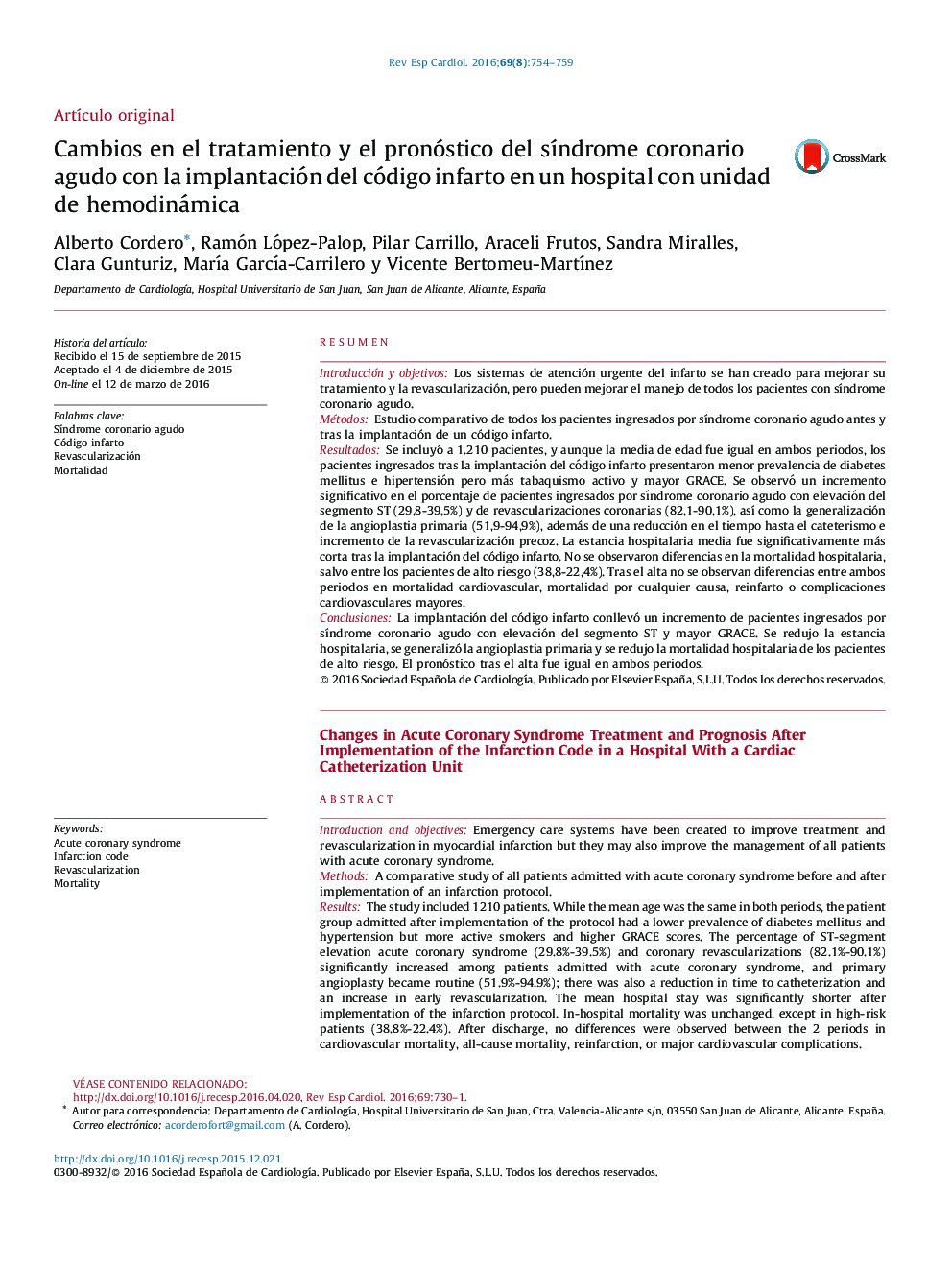| کد مقاله | کد نشریه | سال انتشار | مقاله انگلیسی | نسخه تمام متن |
|---|---|---|---|---|
| 3012679 | 1181826 | 2016 | 6 صفحه PDF | دانلود رایگان |
ResumenIntroducción y objetivosLos sistemas de atención urgente del infarto se han creado para mejorar su tratamiento y la revascularización, pero pueden mejorar el manejo de todos los pacientes con síndrome coronario agudo.MétodosEstudio comparativo de todos los pacientes ingresados por síndrome coronario agudo antes y tras la implantación de un código infarto.ResultadosSe incluyó a 1.210 pacientes, y aunque la media de edad fue igual en ambos periodos, los pacientes ingresados tras la implantación del código infarto presentaron menor prevalencia de diabetes mellitus e hipertensión pero más tabaquismo activo y mayor GRACE. Se observó un incremento significativo en el porcentaje de pacientes ingresados por síndrome coronario agudo con elevación del segmento ST (29,8-39,5%) y de revascularizaciones coronarias (82,1-90,1%), así como la generalización de la angioplastia primaria (51,9-94,9%), además de una reducción en el tiempo hasta el cateterismo e incremento de la revascularización precoz. La estancia hospitalaria media fue significativamente más corta tras la implantación del código infarto. No se observaron diferencias en la mortalidad hospitalaria, salvo entre los pacientes de alto riesgo (38,8-22,4%). Tras el alta no se observan diferencias entre ambos periodos en mortalidad cardiovascular, mortalidad por cualquier causa, reinfarto o complicaciones cardiovasculares mayores.ConclusionesLa implantación del código infarto conllevó un incremento de pacientes ingresados por síndrome coronario agudo con elevación del segmento ST y mayor GRACE. Se redujo la estancia hospitalaria, se generalizó la angioplastia primaria y se redujo la mortalidad hospitalaria de los pacientes de alto riesgo. El pronóstico tras el alta fue igual en ambos periodos.
Introduction and objectivesEmergency care systems have been created to improve treatment and revascularization in myocardial infarction but they may also improve the management of all patients with acute coronary syndrome.MethodsA comparative study of all patients admitted with acute coronary syndrome before and after implementation of an infarction protocol.ResultsThe study included 1210 patients. While the mean age was the same in both periods, the patient group admitted after implementation of the protocol had a lower prevalence of diabetes mellitus and hypertension but more active smokers and higher GRACE scores. The percentage of ST-segment elevation acute coronary syndrome (29.8%-39.5%) and coronary revascularizations (82.1%-90.1%) significantly increased among patients admitted with acute coronary syndrome, and primary angioplasty became routine (51.9%-94.9%); there was also a reduction in time to catheterization and an increase in early revascularization. The mean hospital stay was significantly shorter after implementation of the infarction protocol. In-hospital mortality was unchanged, except in high-risk patients (38.8%-22.4%). After discharge, no differences were observed between the 2 periods in cardiovascular mortality, all-cause mortality, reinfarction, or major cardiovascular complications.ConclusionsAfter implementation of the infarction protocol, the percentage of patients admitted with ST-segment elevation acute coronary syndrome and the mean GRACE score increased among patients admitted with acute coronary syndrome. Hospital stay was reduced, and primary angioplasty use increased. In-hospital mortality was reduced in high-risk patients, and prognosis after discharge was the same in both periods.Full English text available from: www.revespcardiol.org/en
Journal: Revista Española de Cardiología - Volume 69, Issue 8, August 2016, Pages 754–759
